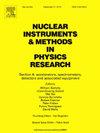Analysis of MOS capacitor with p layer with TCAD simulation
IF 1.5
3区 物理与天体物理
Q3 INSTRUMENTS & INSTRUMENTATION
Nuclear Instruments & Methods in Physics Research Section A-accelerators Spectrometers Detectors and Associated Equipment
Pub Date : 2024-11-09
DOI:10.1016/j.nima.2024.170045
引用次数: 0
Abstract
The ATLAS18 strip sensors of the ATLAS inner tracker upgrade (ITk) are in production since 2021. Along with the large-format n-in-p strip sensor in the center of 6-inch wafer, test structures including Metal–Oxide–Silicon (MOS) capacitors are laid out in the open space for monitoring the performance of the strip sensor and its fabrication process. One of the MOS capacitors is with a p-implantation in the surface of silicon to access the p-stop doping for isolating the n strips, the MOS-p capacitor. The capacitance measurement of the standard MOS capacitor as a function of gate voltage (C–V) shows characteristic behavior in the accumulation, depletion, and inversion regimes, from which one can deduce the amount of the interface charge. The MOS-p capacitor shows the C–V characteristics modulated by the properties of the p-layer. With over 50% of the full production complement delivered, we have observed consistent characteristics in the MOS-p capacitors. Rarely and currently only in three incidents, we have observed anomalous behaviors which implied lower density of p-layer. To study the cause, we have simulated the MOS-p capacitor with a TCAD device simulator. The normal characteristic curve is reproduced successfully with p-density and interface charge within the expected ranges, including a feature caused by a geometrical offset. The anomalous C–V characteristics cannot be explained simply by low p-density, but instead explained with the p-layer density near the specification which goes to zero at the surface. The loss of density could have been introduced with an n-type surface contamination or some other effect such as “dopant segregation”. These simulations have helped to take final acceptance decisions for the batches in production.
利用 TCAD 仿真分析带 p 层的 MOS 电容器
ATLAS 内跟踪器升级版(ITk)的 ATLAS18 带状传感器自 2021 年起投入生产。除了位于 6 英寸晶圆中心的大型 n+-in-p 带状传感器外,还在空地上布置了包括金属氧化物硅(MOS)电容器在内的测试结构,用于监测带状传感器的性能及其制造工艺。其中一个 MOS 电容器是在硅表面植入 p,以获得 p 停止掺杂,从而隔离 n+ 带,即 MOS-p 电容器。标准 MOS 电容器的电容测量值与栅极电压(C-V)呈函数关系,显示出积聚、耗尽和反转状态下的特征行为,从中可以推断出界面电荷量。MOS-p 电容器显示出受 p 层特性调制的 C-V 特性。我们观察到,MOS-p 电容器的特性始终如一。目前,我们仅在三起事件中观察到异常行为,这意味着 p 层密度较低。为了研究原因,我们使用 TCAD 器件模拟器模拟了 MOS-p 电容器。正常特性曲线得以成功再现,p 层密度和界面电荷均在预期范围内,其中包括一个由几何偏移引起的特征。反常的 C-V 特性不能简单地用低 p 密度来解释,而要用接近规格的 p 层密度来解释,因为该密度在表面归零。这种密度损失可能是由于 n 型表面污染或 "掺杂偏析 "等其他效应造成的。这些模拟有助于对生产中的批次做出最终验收决定。
本文章由计算机程序翻译,如有差异,请以英文原文为准。
求助全文
约1分钟内获得全文
求助全文
来源期刊
CiteScore
3.20
自引率
21.40%
发文量
787
审稿时长
1 months
期刊介绍:
Section A of Nuclear Instruments and Methods in Physics Research publishes papers on design, manufacturing and performance of scientific instruments with an emphasis on large scale facilities. This includes the development of particle accelerators, ion sources, beam transport systems and target arrangements as well as the use of secondary phenomena such as synchrotron radiation and free electron lasers. It also includes all types of instrumentation for the detection and spectrometry of radiations from high energy processes and nuclear decays, as well as instrumentation for experiments at nuclear reactors. Specialized electronics for nuclear and other types of spectrometry as well as computerization of measurements and control systems in this area also find their place in the A section.
Theoretical as well as experimental papers are accepted.

 求助内容:
求助内容: 应助结果提醒方式:
应助结果提醒方式:


